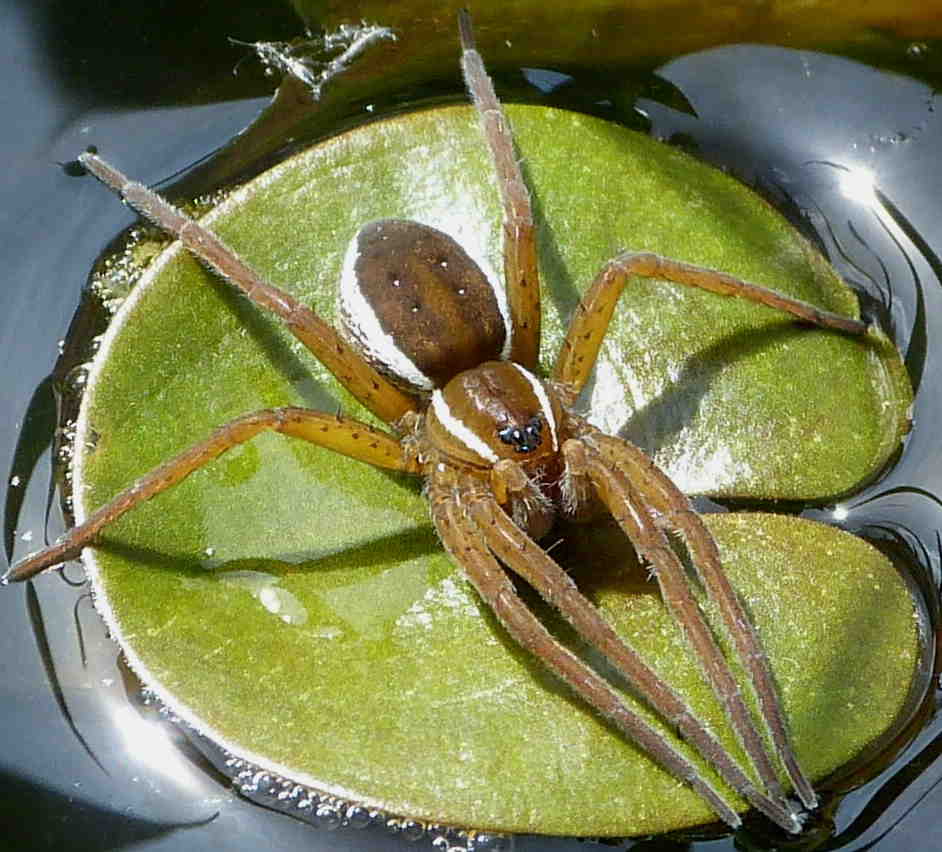Where to see Fen Raft Spiders in Britain
There are currently three British sites with suitable public access where you stand a good chance of spotting a Fen Raft Spider Dolomedes plantarius. Remember at all times though that these animals are strictly protected by law and you must not risk disturbing them, their nurseries or wetland habitat in the vicinity, in trying to see or photograph them. These sites are:
- At Redgrave and Lopham Fen National Nature Reserve (Norfolk/Suffolk), managed by Suffolk Wildlife Trust, there is a way-marked 'spider trail' which guides you past a viewing platform from which the spiders can often be seen (click here for trail guide and information on visitor facilities). You are requested to keep to the main way-parked path to avoid unnecessary disturbance of the spiders and inadvertent destruction of their delicate nursery webs.
- Carlton Marshes Nature Reserve (Suffolk) is one of the sites to which the spiders have been introduced by translocation. Also managed by the Suffolk Wildlife Trust, it has excellent new visitor facilities. The spiders can often be seen on the ditches either side of the main track leading through the reserve. A small foot-bridge immediately to the left of the track is often a good place to look for both adult spiders and their nurseries.
- The tow path of the Tennant Canal near Port Talbot, just east of Swansea in South Wales, is the best viewing point for the spiders in the area. The stretches running east and west from the access point on the B4290 at Jersery Marine are most reliable. In wet years when the shallow ponds are are full, the spiders can sometimes be seen from the boardwalk access around Pant-y-Sais National Nature Reserve, which adjoins the section of the canal immediately east of Jersey Marine; click here for information on location and access.
Unfortunately, there is currently no public access to the more reliable areas for seeing Fen Raft Spiders on the Pevensey Levels in East Sussex. You may be lucky enough to spot one on a ditch visible from a public footpath, or from the road or a road bridge over a drainage channel. Ditches and wider channels with floating rosettes or Water Soldier Stratiotes aloides are most likely to support the spiders but it is worth using binoculars to inspect the margins of channels with dense, marginal emergent vegetation (but not dense Common Reed Phragmites australis).
Spotting Fen Raft Spiders - hints and tips
These spiders are notoriously difficult to spot because of their wonderful cryptic camouflage but they become easier once you've seen one or two and developed a search image. Always approach the viewing point quietly and tread gently - the spiders are very sensitive to vibrations in the ground and water and will often disappear underwater if they detect your approach. It is always worth searching thoroughly with the naked eye before resorting to close-focus binoculars.
The spiders can be active at any time of year in warm sunny weather but you are much more likely to see them from late March through until early October. From mid-April onward you may see males out on the water surface, actively searching for females. Adult females and other life stages are more likely to be seen in basking or hunting positions around the margins of water-bodies, often resting on floating vegetation, or with their back legs on floating or emergent vegetation and their front legs resting on the water surface. From late May, females may be spotted carrying their egg sacs. Sometimes they can be seen pushing the sacs underwater to hydrate them in hot weather. When the sacs are close to hatching, the mother often sits in vegetation anything from 10 cm to over 1 m above the water surface at the site selected for building her nursery. The conspicuous nurseries usually start to appear in late May and can be seen through until early October. The newly-emerged spiderlings occupy the nursery for around five days before dispersing. At this stage they can be seen, usually in a dense, dark ball within the web, along with the remains of the silk sac from which they emerged. Their mother may be seen guarding the nursery - sometimes hidden under the supporting vegetation. Guarding mothers tend to sit in more conspicuous positions later in the season.
... and finally, even if you do not manage to see a Fen Raft Spider, you are sure to enjoy seeing many other wonderful wetland species in these beautiful nature reserves!
